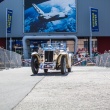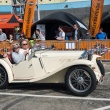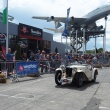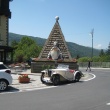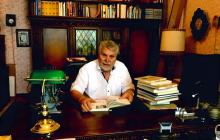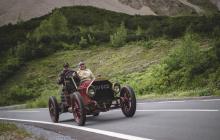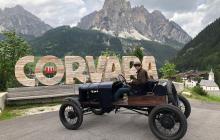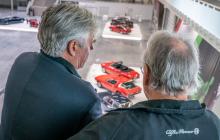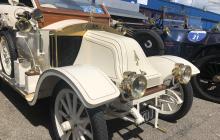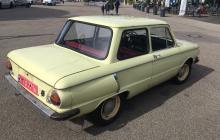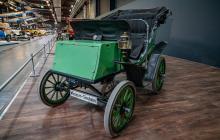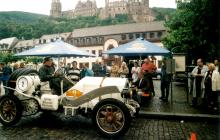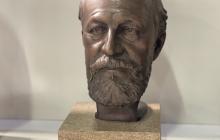A few days ago, one of our museum members from South Tyrol, Andreas C., went on a shopping trip to Tuscany in his MG PA from 1934. Usually, we see him at our BAZZELTAG in Speyer.
I started in my hometown Bolzano at 6.30 am and followed the Strada Statale 12 dell’Abetone e del Brennero until Lucca in Tuscany. This specific Strada Statale begins in Pisa, Tuscany, known for its famous leaning tower, and leads to the Brenner Pass.
In the morning, there was almost no traffic on this Strada Statale, so I could casually drive my MG PA from 1934. The small 870-cc engine was turning at around 3,500 to 4,500 rpm, which equals a speed of 80 to 105 kph. I was moving forward quickly and soon arrived at Trento, where I used the bypass.
South of Trento, the road is not as well-developed anymore but I didn’t mind because: the smaller and more curvy the road becomes, the more fun it is to drive an old car. I was still in the middle of the Adige Valley, which becomes a little narrower shortly before Verona where the road finally follows along the river and rugged rock face. Just like in every other part of Tyrol (north and also south of the Brenner), you can find ruins of former fortifications here. Often, people had to pay a road toll at these points.
I drove round the City of Verona on another bypass and at this occasion also crossed the river Adige. I then continued through the Po Valley to Modena. Once again, I used a bypass. I prefer those roads. It’s just not as much fun torturing oneself with traffic jams in the cities.
Modena, known for balsamic vinegar, is located in the so-called Motor Valley. Nearby, there are the Ferrari, Lamborghini, Maserati, Dallara, and Pagani plants.
Behind Modena, the ascension to the Apennines begins. This mountain range crosses the whole country. Starting off in 4th gear and at quite a good speed in the slightly hilly areas, I finally had to shift into 3rd gear. I still came up to high speed. However, shortly before reaching the top of the pass, I even had to shift into 2nd gear. After all, 37 hp is not a lot. The top of the pass is located at 1,388 metres. Compared to our Dolomite Passes, however, that’s a piece of cake. Still, the steep road took a toll. I took a quick photo and continued downhill towards Lucca. On my way, I passed the old stone arch bridge Ponte della Maddalena. Unfortunately, at the time, there were renovation works going on with heavy machinery, which would have ruined the photo so I decided not to take one.
I finally arrived in Lucca in the evening. I had dinner and went straight to bed. I was quite exhausted from the long ride.
After breakfast the next morning, I visited the estate Tenuta Maria Teresa Duchessa di Lucca. They rent out holiday homes and produce exceptional biological wines, extra virgin olive oil, pasta from their own grains as well as honey. Additionally, you can rent the estate or the park for weddings or similar events. The registry office has a branch at the premises which makes it possible to carry out the official wedding ceremony on site.
I took as many wine boxes with me as there was space in the passenger seat’s leg room and drove back the same way I came. The additional weight didn’t make much of a difference. The small engine with an overhead camshaft driven by a vertical shaft easily drove the car towards the pass in 3rd and 4th gear. For the last kilometres, however, I had to shift into 2nd gear again. That was partly because of the slow drivers in front of me. I wasn’t able to go as fast as I wanted. After reaching the top of the pass, the traffic issues were over and I could enjoy the way back to Modena in my own rhythm, or at least in the rhythm of my car.
After passing Modena and Verona, I could finally see the foothills of the Alps again and went home along the old fortifications. The heat was terrible. Surprisingly, it didn’t have an impact on the car at all. Having added an electric water pump and a fan propeller really paid itself off. Eventually, the driver was the one suffering more. In the evening, I parked the car in the garage and looked forward to taking a shower.
When I checked the next morning, I didn’t notice any cooling water or oil consumption. The more than 800-kilometer-long trip had made the driver more exhausted than his car.
The stories and reports represent the opinions and perspectives of the respective authors. Please note, especially while reading articles about our events, that binding information (e.g. opening hours, admission fees and programme) is only published on the museum's official website www.technik-museum.de.
Please note that the pictures, texts and videos published here are subject to the copyright of the respective authors and / or the museum and may not be used without permission.
Keep up-to-date with new articles
We recommend to subscribe to the museum’s newsletter via e-mail. At the end of each newsletter, we inform you about new articles so that you will not miss any of them. Alternatively, you can subscribe to an RSS feed:
Subscribe to newsletter RSS-Feed (Reader required)

